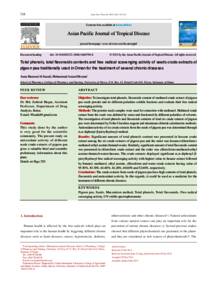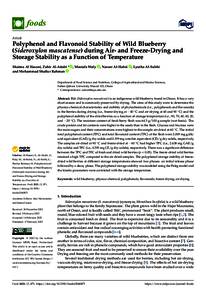Document
Total phenols, total flavonoids contents and free radical scavenging activity of seeds crude extracts of pigeon pea traditionally used in Oman for the treatment of several chronic diseases.
Identifier
DOI: 10.1016/S2222-1808(14)60790-8
Contributors
Hossain, Mohammad Amzad., Author
Publisher
Elsevier.
Gregorian
2015-04
Language
English
English abstract
Objective: To investigate total phenols, flavonoids content of methanol crude extract of pigeon pea seeds powder and its different polarities soluble fractions and evaluate their free radical scavenging activity. Methods: The powder seeds samples were used for extraction with methanol. Methanol crude extract from the seeds was defatted by water and fractioned by different polarities of solvents. The investigation of total phenols and flavonoids contents of total six crude extracts of pigeon pea were determined by Folin-Ciocalteu reagent and aluminum chloride calorimetric methods. Antioxidant activity of six crude extracts from the seeds of pigeon pea was determined through α,α-diphenyl-β-picrylhydrazyl method. Results: Significant amount of total phenols content was presented in hexane crude extract among the six crude extracts of pigeon pea and the order was hexane>chloroform> methanol>ethyl acetate>butanal>water. Similarly, significant amount of total flavonoids content was presented in chloroform crude extract and the order was chloroform>methanol>ethyl acetate>butanol>water>hexane. The crude extracts displayed significant α,α-diphenyl-β-picrylhydrazyl free radical scavenging activity with highest value in hexane extract followed by butanol, methanol, ethyl acetate, chloroform and water crude extracts having value of 95.50%, 83.30%, 64.60%, 64.20%, 60.60% and 52.60%, respectively. Conclusions: The crude extracts from seeds of pigeon pea have high contents of total phenols, flavonoids and antioxidant activity. In this regards, it could be used as a medicine for the treatment of different chronic diseases.
Member of
ISSN
2222-1808
Resource URL
Category
Journal articles


